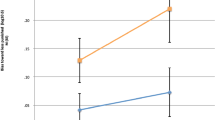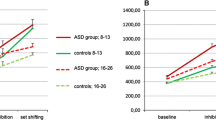Abstract
Two experiments examined whether over-selectivity is the product of a post-acquisition performance deficit, rather than an attention problem. In both experiments, children with Autistic Spectrum Disorder were presented with a trial-and-error discrimination task using two, two-element stimuli and over-selected in both studies. After behavioral control by the previously over-selected stimulus was extinguished, behavioral control by the previously under-selected cue emerged without direct training. However, this effect was only found in higher-functioning children, and not with more severely impaired children. These findings suggest that over-selectivity is not simply due to a failure to attend to all of the stimuli presented. They also suggest that extinction of over-selected stimuli may be a fruitful line of intervention for clinical intervention for some individuals.


Similar content being viewed by others
References
Allen, K. D., & Fuqua, R. W. (1985). Eliminating selective stimulus control: A comparison of two procedures for teaching mentally retarded children to respond to compound stimuli. Journal of Experimental Child Psychology, 39, 55–71. doi:10.1016/0022-0965(85)90029-3.
Anderson, C. J., Colombo, J., & Shaddy, J. (2006). Visual scanning and pupillary responses in young children with autistic spectrum disorder. Journal of Clinical and Experimental Neuropsychology, 28, 1238–1256. doi:10.1080/13803390500376790.
Birnie-Selwyn, B., & Guerin, B. (1997). Teaching children to spell: Decreasing consonant cluster errors by eliminating selective stimulus control. Journal of Applied Behavior Analysis, 30, 69–91. doi:10.1901/jaba.1997.30-69.
Broomfield, L., McHugh, L., & Reed, P. (2008a). Re-emergence of under-selected stimuli, after the extinction of over-selected stimuli in an automated match to samples procedure. Research in Developmental Disabilities.
Broomfield, L., McHugh, L., & Reed, P. (2008b). The effect of observing response procedures on the reduction of over-selectivity in a match to sample task: Immediate but not long term benefits. Research in Developmental Disabilities, 29, 217–234.
Constantine, B., & Sidman, M. (1975). Role of naming in delayed matching-to-sample. American Journal of Mental Deficiency, 79, 680–689.
Dickinson, A., & Burke, J. (1996). Within compound associations mediate the retrospective revaluation of causality judgements. Quarterly Journal of Experimental Psychology, 49, 60–80.
Dickson, C. A., Wang, S. S., Lombard, K. M., & Dube, W. V. (2006). Over selective stimulus control in residential school students with intellectual disabilities. Research in Developmental Disabilities, 27, 618–631. doi:10.1016/j.ridd.2005.07.004.
Dunn, L. M., Dunn, L. M., Whetton, C., & Burley, J. (1997). The British Picture Vocabulary Scale (2nd ed.). London: NFER-Nelson.
Dunn, L. M., Dunn, L. M., Whetton, C., & Pintilie, D. (1982). British Picture Vocabulary Scale. Windsor, Berks: NFER Nelson.
Dube, W. V., Lombard, K. M., Farren, K. M., Flusser, D., Balsamo, L. M., & Fowler, T. R. (1999). Eye tracking assessment of stimulus over selectivity in individuals with mental retardation. Experimental Analysis of Human Behavior Bulletin, 13, 267–271.
Dube, W. V., & McIlvane, W. J. (1997). Reinforcer frequency and restricted stimulus control. Journal of the Experimental Analysis of Behavior, 68, 303–316. doi:10.1901/jeab.1997.68-303.
Dube, W. V., & McIlvane, W. J. (1999). Reduction of stimulus over selectivity with nonverbal differential observing responses. Journal of Applied Behavior Analysis, 32, 25–33. doi:10.1901/jaba.1999.32-25.
Frankel, F., Simmons, J. Q., Fichter, M., & Freeman, B. J. (1984). Stimulus overselectivity in autistic and mentally retarded children-a research note. Journal of Child Psychology and Psychiatry, 25, 147–155. doi:10.1111/j.1469-7610.1984.tb01727.x.
Gibson, E., & Reed, P. (2005). Stimulus over-selectivity in rats. Journal of Autism and Developmental Disorders, 35, 851–859. doi:10.1007/s10803-005-0030-9.
Huguenin, N. H. (1997). Employing computer technology to assess visual attention in young children and adolescents with severe mental retardation. Journal of Experimental Child Psychology, 65, 141–170. doi:10.1006/jecp. 1996.2357.
Kaufman, M. A., & Bolles, R. C. (1981). A non associative aspect of overshadowing. Bulletin of the Psychonomic Society, 18, 318–320.
Koegel, R. L., & Schreibman, L. (1977). Teaching autistic children to respond to simultaneous multiple cues. Journal of Experimental Child Psychology, 24, 299–311. doi:10.1016/0022-0965(77)90008-X.
Koegel, R. L., Schreibman, L., Britten, K., & Laitinen, R. (1979). The effects of schedule of reinforcement on stimulus overselectivity in autistic children. Journal of Autism and Developmental Disorders, 9, 383–397. doi:10.1007/BF01531446.
Koegel, R. L., & Wilhelm, H. (1973). Selective responding to multiple cues by autistic children. Journal of Experimental Child Psychology, 15, 442–453. doi:10.1016/0022-0965(73)90094-5.
Kemner, C., & Van Engeland, H. (2006). ERPs and eye movements reflect atypical visual perception in pervasive developmental disorder. Journal of Autism and Developmental Disorders, 36, 45–54. doi:10.1007/s10803-005-0041-6.
LeBlanc, L. A., Carr, J. E., Crossett, S. E., Bennett, C. M., & Detweiler, D. M. (2005). Intensive outpatient behavioral treatment of primary urine incontinence of children with autism. Focus on Autism and Other Developmental Disabilities, 20, 98–105. doi:10.1177/10883576050200020601.
Litrownik, A. J., McInnis, E. T., Wetzel-Pritchard, A. M., & Filipelli, D. L. (1978). Restricted stimulus control and inferred attentional deficits in autistic and retarded children. Journal of Abnormal Psychology, 87, 554–562. doi:10.1037/0021-843X.87.5.554.
Lovaas, O. I., Berberich, J. P., Perloff, B. F., & Schaeffer, B. (1966). Acquisition of imitative speech in schizophrenic children. Science, 151, 705–707. doi:10.1126/science.151.3711.705.
Lovaas, O. I., Koegel, R. L., & Schreibman, L. (1979). Stimulus overselectivity in autism: A review of research. Psychological Bulletin, 86, 1236–1253. doi:10.1037/0033-2909.86.6.1236.
Lovaas, O. I., & Schreibman, L. (1971). Stimulus over selectivity of autistic children in a two stimulus situation. Behaviour Research and Therapy, 9, 305–310. doi:10.1016/0005-7967(71)90042-8.
Lovaas, O. I., Schreibman, L., Koegel, R., & Rehm, R. (1971). Selective responding by autistic children to multiple sensory inputs. Journal of Abnormal Psychology, 77, 211–222. doi:10.1037/h0031015.
Matzel, L. D., Schachtman, T. R., & Miller, R. R. (1985). Recovery of an overshadowed association achieved by extinction of the overshadowing stimulus. Learning and Motivation, 16, 398–412. doi:10.1016/0023-9690(85)90023-2.
McHugh, L., & Reed, P. (2007). Age trends in stimulus over-selectivity. Journal of the Experimental Analysis of Behavior, 88, 369–380. doi:10.1901/jeab.2007.88-369.
Meisel, C. J. (1981). Stimulus over-selectivity by mentally retarded adolescents: Effects of pre-training on cue identification. American Journal of Mental Deficiency, 86, 317–322.
Miller, R. R., & Matzel, L. D. (1988). The comparator hypothesis: A response rule for the expression of associations. In G. H. Bower (Ed.), The psychology of learning and motivation (Vol. 22, pp. 51–92). San Diego, CA: Academic Press.
Pascualvaca, D., Fantie, B., Papageorgiou, M., & Mirsky, A. (1998). Attentional capacities in children with autism: Is there a general deficit in shifting focus? Journal of Autism and Developmental Disorders, 28, 467–478. doi:10.1023/A:1026091809650.
Plaisted, K., O’Riordan, M., & Baron-Cohen, S. (1998). Enhanced discrimination of novel, highly similar stimuli by adults with autism during a perceptual learning task. Journal of Child Psychology and Psychology, 39, 765–775. doi:10.1017/S0021963098002601.
Reed, P. (2006). The effect of retention interval on stimulus over-selectivity using a matching to sample procedure. Journal of Autism and Developmental Disorders, 36, 1115–1121. doi:10.1007/s10803-006-0148-4.
Reed, P., & Gibson, E. (2005). The effect of concurrent task load on stimulus over selectivity. Journal of Autism and Developmental Disorders, 35, 601–614. doi:10.1007/s10803-005-0004-y.
Reed, P., & Reilly, S. R. (1990). Context extinction following conditioning with delayed reward enhances subsequent instrumental responding. Journal of Experimental Psychology Animal Behavior Processes, 16, 48–55. doi:10.1037/0097-7403.16.1.48.
Reilly, S., Schachtman, T. R., & Reed, P. (1996). Signaled delay of reinforcement: Effects of postconditioning manipulation of context associative strength on instrumental performance. Learning and Motivation, 27, 451–463. doi:10.1006/lmot.1996.0026.
Remington, R. W. (1980). Attention and saccadic eye movement. Journal of Experimental Human Perception and Performance, 6, 726–744. doi:10.1037/0096-1523.6.4.726.
Schneider, H. C., & Salzberg, C. L. (1982). Stimulus over-selectivity in a match-to sample paradigm by severely retarded youth. Analysis and Intervention in Developmental Disabilities, 2, 273–304. doi:10.1016/0270-4684(82)90025-8.
Schover, L. R., & Newsom, C. D. (1976). Overselectivity, developmental level, and overtraining in autistic and normal children. Journal of Abnormal Child Psychology, 4, 289–298. doi:10.1007/BF00917765.
Schreibman, L. (1997). Theoretical perspectives on behavioral intervention for individuals with autism. In D. J. Cohen & F. R. Volkmar (Eds.), Handbook of autism and pervasive developmental disorders (2nd ed., pp. 920–933). New York: Wiley.
Schreibman, L., Charlop, M. H., & Koegel, R. L. (1982). Teaching autistic children to use extra-stimulus prompts. Journal of Experimental Child Psychology, 33, 475–491. doi:10.1016/0022-0965(82)90060-1.
Schreibman, L., & Lovaas, O. I. (1973). Over selective response to social stimuli by autistic children. Journal of Abnormal Child Psychology, 1, 152–168. doi:10.1007/BF00916110.
Stromer, R., McIlvane, W. J., Dube, W. V., & Mackay, H. A. (1993). Assessing control by elements of complex stimuli in delayed matching to sample. Journal of the Experimental Analysis of Behavior, 59, 83–102. doi:10.1901/jeab.1993.59-83.
Treisman, A. M. (1969). Strategies and models for selective attention. Psychological Review, 76, 282–299. doi:10.1037/h0027242.
Van der Geest, J. N., Kemner, C., Camfferman, G., Verbaten, M. N., & Van Engeland, H. (2002). Looking at images with human figures: Comparison between autistic and normal children. Journal of Autism and Developmental Disorders, 32, 69–75. doi:10.1023/A:1014832420206.
Wayland, S., & Taplin, J. E. (1985). Feature-processing deficits following brain injury I. Over selectivity in recognition memory for compound stimuli. Brain and Cognition, 4, 338–355. doi:10.1016/0278-2626(85)90026-0.
Wilhelm, H., & Lovaas, O. I. (1976). Stimulus over selectivity: A common feature in autism and mental retardation. American Journal of Mental Deficiency, 81, 26–31.
Willkie, D. M., & Masson, M. E. (1976). Attention in the pigeon: A re-evaluation. Journal of the Experimental Analysis of Behavior, 26, 207–212. doi:10.1901/jeab.1976.26-207.
Acknowledgments
We would like to acknowledge the kind participation of the children and their parents in this research, and we thank them very much for their time. Thanks are due to the schools who participated. Thanks are due to Lisa A. Osborne for her support. This research was funded in part by a grant from the Disabilities Trust to the first author.
Author information
Authors and Affiliations
Corresponding author
Rights and permissions
About this article
Cite this article
Reed, P., Broomfield, L., McHugh, L. et al. Extinction of Over-selected Stimuli Causes Emergence of Under-selected Cues in Higher-functioning Children with Autistic Spectrum Disorders. J Autism Dev Disord 39, 290–298 (2009). https://doi.org/10.1007/s10803-008-0629-8
Received:
Accepted:
Published:
Issue Date:
DOI: https://doi.org/10.1007/s10803-008-0629-8




